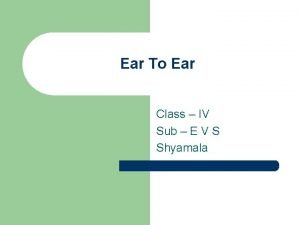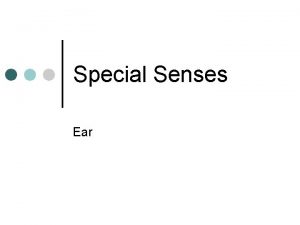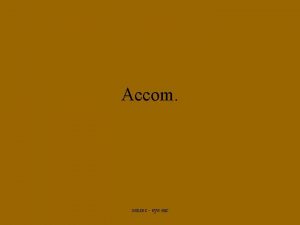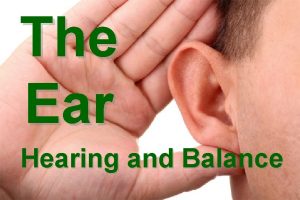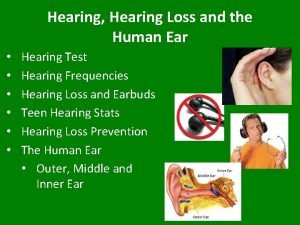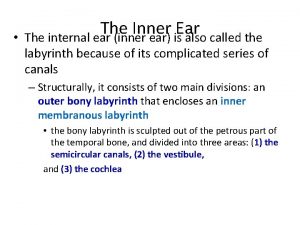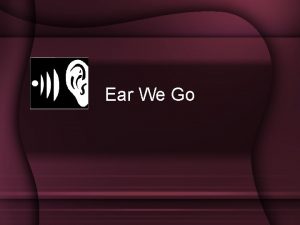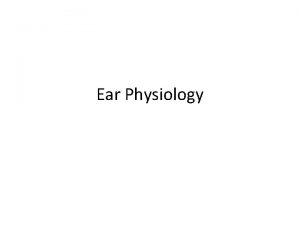The Ear Houses two senses 1 Hearing 2












- Slides: 12

The Ear § Houses two senses 1) Hearing 2) Equilibrium (balance) § Mechanoreceptors – receptors that respond to physical forces; both respond to movements of fluid § Different organs house receptors for each sense and are independent of each other.

Anatomy of the Ear § The ear is divided into three areas 1) Outer (external) ear 2) Middle ear 3) Inner ear Figure 8. 12

The External Ear § Involved in hearing only § Structures of the external ear 1) Pinna (auricle) 2) External auditory canal Figure 8. 12

The External Auditory Canal § Narrow chamber in the temporal bone § Lined with skin § Ceruminous (wax) glands are present § https: //www. youtube. com/watch? v=QJV 0 COt. SPdo § https: //www. youtube. com/watch? v=QHOX 1 R 5 b 770 § Ends at the tympanic membrane

The Middle Ear or Tympanic Cavity § Air-filled cavity within the temporal bone § Only involved in the sense of hearing

The Middle Ear or Tympanic Cavity § Tympanic membrane (Eardrum) – Skin covering the opening of the middle ear; stretched tight to sense vibrations like a drum head. § Auditory tube connects the middle ear with the throat § Allows for equalizing pressure during yawning or swallowing; otherwise this tube is collapsed

The Middle Ear or Tympanic Cavity § Homeostatic Imbalance § Otitis Media (Ear Infection) – inflammation of the middle ear. § Symptoms: eardrum bulges from large amounts of fluid in the cavity as it fights the infection. The pressure causes pain and can rupture the eardrum § Tubes can be placed in the eardrum so that the fluids drain to relieve pressure

The Middle Ear or Tympanic Cavity § Homeostatic Imbalance: Otitis media continued § Usually results from bacteria infection in the throat area; sore throat. § Problem in small children whose auditory tube runs more horizontal § Don’t “prop” a bottle or feed a baby lying flat because it can enter the tube § http: //www. youtube. com/watch? v=T 8 g 62 Fygepg

Bones of the Tympanic Cavity § Three bones span the cavity § Malleus (hammer) § Incus (anvil) § Stapes (stirrup) Figure 8. 12

Bones of the Tympanic Cavity § Vibrations from eardrum move the malleus § These bones transfer sound to the inner ear § If you have problems with these bones … you don’t hear!! Figure 8. 12

Inner Ear or Bony Labyrinth § Includes sense organs for hearing and balance § Filled with perilymph which is a plasma-like fluid Figure 8. 12

Inner Ear or Bony Labrynth § A maze of bony chambers within the temporal bone § 3 subdivisions of the Inner Ear 1) Cochlea 2) Vestibule 3) Semicircular canals Figure 8. 12
 What is the difference between somatic and special senses
What is the difference between somatic and special senses General senses vs special senses
General senses vs special senses Houses the receptors for hearing
Houses the receptors for hearing Discount houses examples in india
Discount houses examples in india Animals whose ears we cannot see
Animals whose ears we cannot see An animal whose ears we cannot see
An animal whose ears we cannot see Prologue romeo and juliet in modern english
Prologue romeo and juliet in modern english Two households both alike
Two households both alike 2 houses of congress
2 houses of congress Hát kết hợp bộ gõ cơ thể
Hát kết hợp bộ gõ cơ thể Ng-html
Ng-html Bổ thể
Bổ thể Tỉ lệ cơ thể trẻ em
Tỉ lệ cơ thể trẻ em





